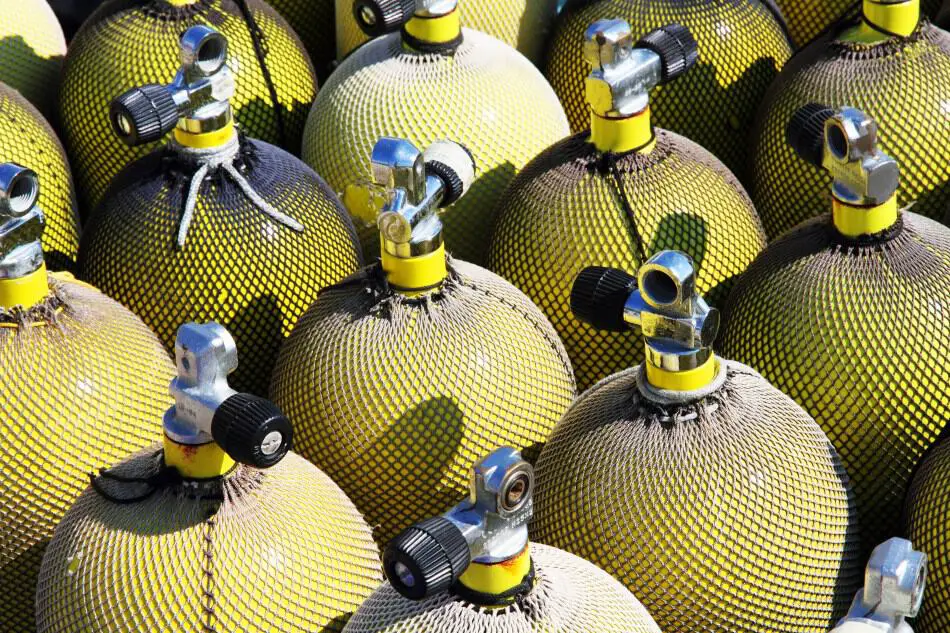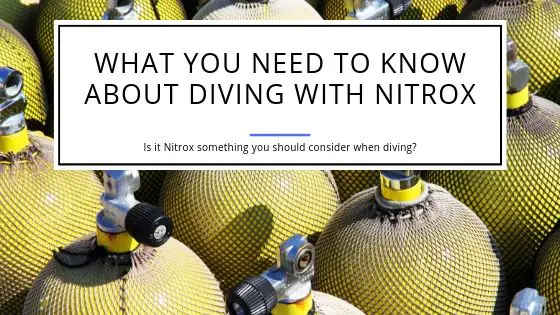What you need to know about Diving with Nitrox
Nitrogen and Oxygen are part of the air we breathe. During diving, Nitrogen concentrations increase in the body and can cause decompression sickness (the bends) when you ascend too fast.
The thought behind Nitrox is that the concentration of nitrogen in the gas you breathe is reduced while the concentration of oxygen is increased. This will result in less nitrogen being absorbed during diving and as such the need for decompression stops is reduced. In other words, you can dive longer without having to make decompression stops or risking decompression sickness.
Guide to Nitrox Diving
It’s a simple idea and it works very well at moderate diving depths. If diving deep the Oxygen can actually cause Oxygen poisoning and Nitrox will actually increase that possibility.
Oxygen in the air is concentrated at around 21%. Any diving mix that has an increased level of Oxygen is basically called Nitrox. You might also have seen it abbreviated as EAN (Enriched Air Nitrox).
Nitrox in diving has been around for over 25 years. It started slow but has become common among all levels of Scuba diving and made the sport overall safer.
The two most popular and common mixes of Nitrox are 32% (EAN32) and 36% (EAN36) of Oxygen. Both blends are easily available at any dive location. EAN-32 is sometimes also referred to as Nitrox I and EAN-36 is often named Nitrox II.
You know that you’re looking at a Nitrox mix when you see the yellow and green label on the tank. If you get a tank filled with Nitrox then you should use an oxygen/nitrox analyzer to verify the concentration.
Dive Deeper with Nitrox?
It is a misconception that you can dive deeper with Nitrox. As mentioned above, the deeper you dive, the higher the pressure gets. Oxygen will get poisonous at high pressures and will cause Oxygen poisoning.
Nitrox does however allow to dive longer at the same depths compared to breathing regular air. Regular air has a concentration of around 21% Oxygen. Using regular air, you have a bottom time of around 35 minutes at 80 feet (24 meters) for your first dive.
Using Nitrox I you can dive for that same time at 100 feet (30 meters). To say it differently, your body will absorb the same amount of Nitrogen at 100 ft using EAN-32 as it does at 80 ft using air.
Nitrox does allow to dive deeper (within limits) while extending bottom time. It might make more sense for recreational divers or beginners to simply take the added safety of being able to stay longer at the same depth instead of trying to go deeper. In the end you can either dive deeper with the same bottom time or extend your bottom time if you don’t go deeper.
We briefly touched on the issue that oxygen under pressure can become toxic to humans. We’ll explain this a little further in the following. There’s a lot more to learn and to understand if you get a Nitrox certification.
The partial pressure of oxygen on land is .21 ata (also referred to as PPO2). This reflects the 21% oxygen in the air times the atmospheric pressure. During a dive the pressure surrounding you is increased. This will change the partial pressure of oxygen.
When you dive to 33 feet (10 meters) the pressure reaches 2 ATM. In turn the partial pressure of oxygen rises to .42 if we breathe air. This is roughly the point where our body’s reaction to oxygen changes and it starts to get toxic.
To be clear though, to have an issue at that depth would require a diver to stay down for much longer than it’s possible. The brain will start to be affected if the PPO2 rises to 1.6 ata. At that level serious health issues and even death is possible.
The maximum safe level of partial pressure is commonly set to 1.4 ata. This level would be reached at a depth of 185 feet (56 meters) if breathing Air. This is where Nitrox becomes the issue though. Due to the higher concentration of oxygen in the gas, the maximum depth with Nitrox II is reached at only 94 feet (28 meters)!
The higher the concentration of Oxygen in the gas, the lower that maximum depth gets. If you’d use Nitrox with a 38% Oxygen level then the depth to reach 1.4 ata is only 87 feet (26 meters). The depth at which 1.4 ata are reached is also referred to as Maximum Operating Depth (MOD).
You can calculate the PPO2 levels for yourself. Take the atmospheric pressure times the oxygen concentration. For example, diving with Nitrox I at 132 feet results in 5 ATM * 0.32 which results in a PPO2 level of 1.6.
The MOD diving with Nitrox is well within the limits of a deep diver. Therefore, it is very important to take this into consideration when preparing for a dive.
The effects of Oxygen on the body when the partial pressure goes higher than 1.4 ata are similar to Nitrogen in the body and can in the worst case be deadly! At that level there is more oxygen in the body than is required for the metabolism.
The oxygen bonds to the hemoglobin or the gas dissolves in the bloodstream. At that moment the hemoglobin can no longer transport carbon dioxide to the lungs and both gases build up in the body. The blood flow to the brain gets reduced and eventually the central nervous system is affected. This will cause seizures and convulsions, ear ringing, twitching and nausea, and other symptoms like dizziness.
To recapture here once more: Nitrox does NOT allow you to dive deeper!
When to use Nitrox for Diving?
As outlined, Nitrox won’t be a good choice to dive deeper. However, it is a great choice to allow you to dive longer. It won’t make a difference if you dive in shallow water, up to 50 feet. The no-decompression times for Air in that case are typically so long that you’ll run out of air before you run into any limits.
Image by David Weekly on Flickr
If you dive in the range of 50 feet to 100 feet you’ll typically get the most benefit from using Nitrox. It’ll allow you to significantly stay down longer which means there’s more underwater sightseeing for you…
Dives with Nitrox enable you to have longer repetitive dive times. You absorb less nitrogen during each dive which means your subsequent dives can be longer. This can be a significant advantage if you dive in an environment where there’s lots to see. You can dive longer each time which allows you to see more of your environment under water.
Increased Safety
You will enjoy increased safety during dives assuming that you will not dive down to deep depths where PPO2 levels could become an issue. If you ever suffered from the bends and you want to be extra careful then calculate your dive times as if you were using Air but then use Nitrox.
If you for example dive to 60 feet and you use the calculations for air then you’d still have around 60 minutes of safety if you instead use EAN36! This is a significant buffer and basically guarantees that you won’t hit any no-decompression limit. As outlined above, don’t do that though if you decide to dive to deeper depths!

What Mix to Pick?
Most dive shops will have EAN 32 available. This makes their and the diver’s life easy as it’s a known concentration. It’s easiest for them to mix only one concentration.
However, if you use Nitrox I at 70 feet then it really only adds around 10 minutes to your bottom time of around 50 minutes. If you could use Nitrox at a 40% oxygen level, you could double your bottom time at that depth. That’s quite a substantial increase in bottom time.
When you plan your dive you might want to consider calling a few dive shops in the area to see whether they can blend a tank with higher oxygen concentrations. Most dive shops will not have a problem doing that with a little bit of lead time as long as the oxygen levels stay under the recreational limit of 40 percent.
Using a Dive Computer with Nitrox
Most of today’s dive computers are capable of handling Nitrox. They at least have the settings for the most common mixes (32% and 36%). Higher end models are capable to adjust the mixes up to 50% so you get the correct readings from the dive computer.
If you have a model that has preset mixes, then make sure to round in the right direction. This typically will result in you rounding up. Let’s say your dive computer has settings for 32% and 36% and your tank is a 34% mix. In most cases you want to set your dive computer to use the preset 36%. This will increase the safety margin with regards to the diving depth calculations that your dive computer will perform.
If you are planning though to stay relatively shallow but you want to go for a long dive, then it’s better to use the lower setting. That would reduce the maximum bottom time which on the other hand increases your safety margin.
Even with a dive computer you might need to have a thorough understanding of the effects of Nitrox to the bottom time and the dive depths. Make sure you understand those basics before diving!
Final Thoughts on Nitrox
Nitrox made recreational diving safer. However, it’s not made it idiot-proof. You still have to know what you’re doing. You have to have your tank prepared for Nitrox use and you should be certified to dive with Nitrox.
Nitrox will allow you to dive safer and longer. Due to the lower absorption of nitrogen you also feel more refreshed after a dive which is a nice side effect. It also puts overall less stress on the body if you don’t go to the limits of using Nitrox underwater.
It is highly recommended that you use a good dive computer that is capable of having the correct oxygen concentration be set by you. This way you get the most accurate calculations based on the gas you’re using. Check out your selection of the best dive computers for more information!

